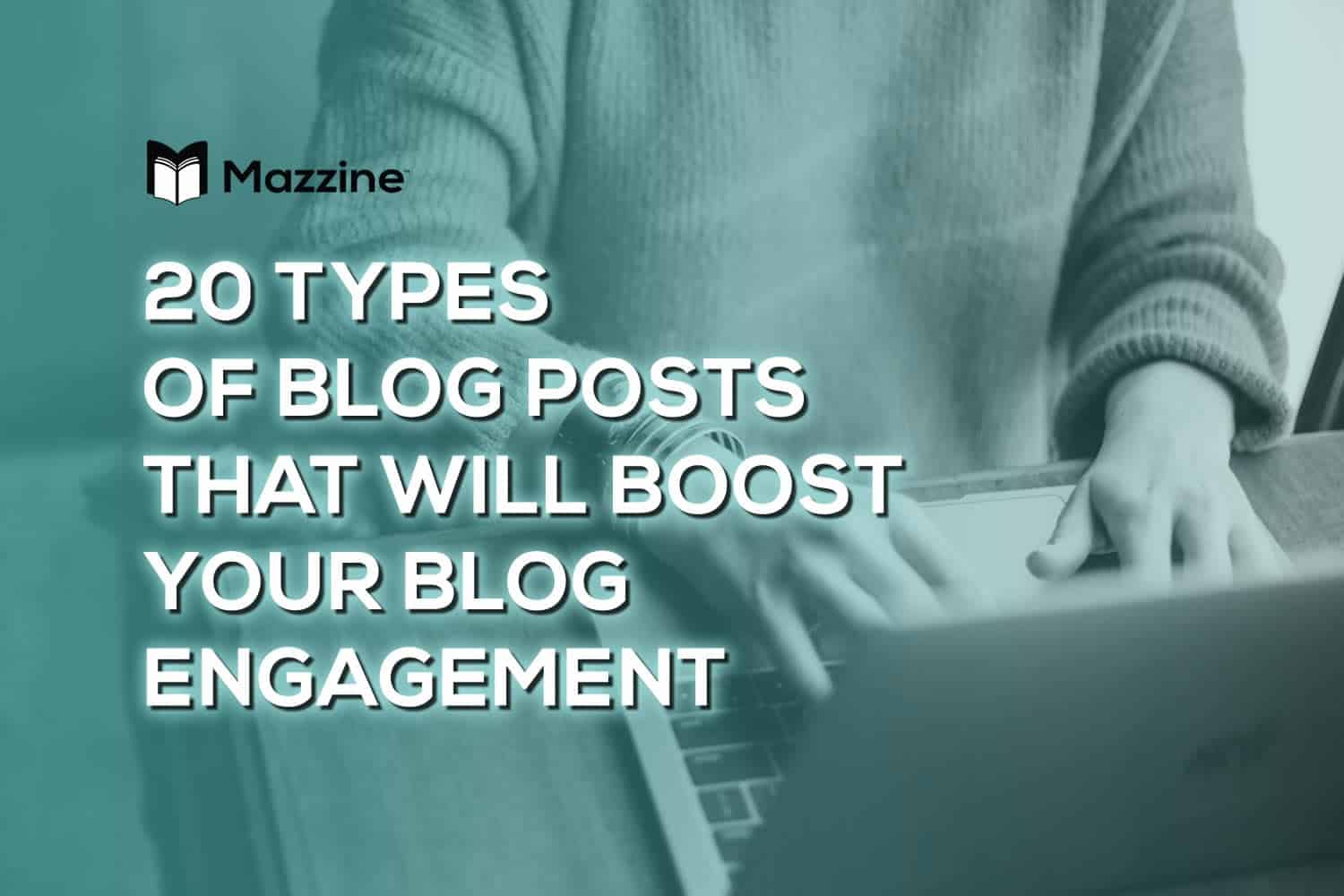As a blogger, you know that creating engaging content is key to building a loyal following and increasing your blog’s visibility. But with so many types of blog posts out there, blogging can be challenging to determine what will resonate with your audience and keep them coming back for more.
In this article, we’ll explore 20 different types of blog posts that are proven to boost engagement and help you connect with your readers on a deeper level. Whether you’re just starting out or looking to revamp your blog’s content strategy, you’ll find plenty of inspiration and actionable tips here.
From listicles to how-to guides, case studies to personal stories, these blog post types are designed to capture your readers’ attention, provide value, and encourage them to share your content with their own networks. So let’s dive in and discover the secrets to creating compelling blog posts that drive engagement and grow your blog’s audience.
Table of Contents
List of 20 Types of Blog Posts

- How-to Guides
- Listicles
- Reviews
- Interviews
- Case Studies
- Infographics
- Personal
- News and Current Events
- Opinions and Editorials
- Q&A
- Product Comparisons
- Roundups
- Controversial Topics
- Predictions and Trends
- Beginner’s Guides
- Myth-busting
- Resource Lists
- Case Studies
- Behind-the-Scenes
- Guest Posts
1. How-to Guides
How-to guides are one of the most popular types of blog posts that provide step-by-step instructions on how to perform a task or solve a problem. They are usually structured in a logical manner with clear and concise explanations, making them easy to follow.
Pros:
- Highly actionable and practical content.
- Provide value to readers by helping them solve specific problems.
- Attract traffic from search engines and social media platforms.
Cons:
- Require extensive research and time to create.
- May not be suitable for all types of blogs.
- Need to be updated frequently to remain relevant.
2. Listicles
Listicles are blog posts that feature a list of items that share a common theme or topic. They are often formatted as numbered or bulleted lists, making them easy to read and digest. Listicles can cover a wide range of topics, from tips and tricks to product recommendations.
Pros:
- Easy to read and share on social media platforms.
- High potential for virality and social sharing.
- Great for generating engagement and discussion.
Cons:
- Can be perceived as shallow or lacking in depth.
- Can become repetitive if overused.
- May not provide enough value for readers.
3. Reviews
Reviews are blog posts that provide an evaluation of a product, service, or experience. They can be either positive or negative and often include a rating system or a summary of the reviewer’s experience. Reviews can cover a wide range of topics, from books and movies to restaurants and hotels.
Pros:
- Provide valuable insights for readers who are considering a purchase.
- Can establish the blogger as an authority in a particular niche.
- Can generate affiliate revenue for the blogger.
Cons:
- Require extensive testing and research.
- May result in biased or inaccurate reviews if the blogger has a conflict of interest.
- Can be perceived as promotional or self-serving.
4. Interviews
Interviews are blog posts that feature a conversation between the blogger and a guest, often an expert in a particular field or industry. They can be conducted in various formats, such as written or audio, and provide valuable insights and perspectives on a particular topic.
Pros:
- Provide unique and valuable insights from experts.
- Can attract new readers and followers from the guest’s audience.
- Can generate engagement and discussion.
Cons:
- Require time and effort to coordinate and conduct the interview.
- May not appeal to all readers.
- May require editing and transcription.
5. Case Studies
Case studies are blog posts that showcase a particular problem, challenge, or success story and provide an in-depth analysis of the situation. They often include data, statistics, and testimonials to support the analysis and provide valuable insights for readers.
Pros:
- Provide valuable insights and actionable takeaways for readers.
- Can establish the blogger as an authority in a particular niche.
- Can attract traffic from search engines and social media platforms.
Cons:
- Require extensive research and data analysis.
- May not be suitable for all types of blogs.
- May require permission or clearance from the subjects involved.
6. Infographics
Infographics are blog posts that feature visual representations of data, statistics, or information. They are often designed to be easy to read and share and can cover a wide range of topics.
Pros:
- Highly shareable on social media platforms.
- Can generate backlinks and traffic from other websites.
- Provide an engaging and visually appealing way to present information.
Cons:
- Require design skills or the help of a graphic designer.
- Can be time-consuming and expensive to create.
- May not be suitable for all types of content.
7. Personal Blog Posts
Personal blog posts are written based on the author’s personal experiences, thoughts, and feelings. These types of posts are usually more informal and conversational in tone and are often used to create a stronger connection with the audience. The author can write about their daily life, hobbies, interests, or share their personal stories to engage the audience.
Pros:
- Can create a strong emotional connection with readers
- Show the author’s personality and authenticity
Cons:
- Might not be relevant to the readers
- Can be too self-indulgent if not written well
8. News and Current Events Blog Posts
News and current events blog posts focus on timely topics related to the industry, the world, or the niche. They provide readers with the latest updates, news, and opinions on current events that are relevant to the blog’s niche. These types of posts require regular research and monitoring to ensure that the information is current and accurate.
Pros:
- Can attract a wide range of readers interested in the topic
- Can position the author as an expert on the subject
Cons:
- Might require a lot of research and time
- The content can become outdated quickly
9. Opinions and Editorials Blog Posts
Opinions and editorials blog posts are written to express the author’s opinion on a particular topic or issue. They are often used to start a discussion or debate among the audience. These posts are usually more subjective in nature and can be controversial at times.
Pros:
- Can spark engagement and discussion among readers
- Can show the author’s unique perspective on the topic
Cons:
- Can be polarizing and lead to negative comments and backlash
- Might not be well received by readers who have different opinions
10. Q&A Blog Posts
Q&A blog posts are a great way to engage with the audience and provide them with valuable information. They usually consist of a list of questions and answers related to a particular topic or issue. The author can answer frequently asked questions, or provide insights into the topic. Pros:
- Can provide valuable information to the readers
- Can help the author connect with the audience Cons:
- Might not be suitable for all types of blogs
- Can become repetitive if the same questions are answered repeatedly
11. Product Comparisons Blog Posts
Product comparison blog posts are often used by affiliate marketers to promote products and earn commissions. These posts compare and contrast different products in the same category, highlighting the features, benefits, and drawbacks of each.
Pros:
- Can help readers make informed decisions when purchasing products
- Can be lucrative for affiliate marketers
Cons:
- Might not be suitable for all types of blogs
- Can come across as biased if not written objectively
12. Roundups Blog Posts
Roundup blog posts are a collection of links, resources, or products related to a particular theme or topic. These posts provide readers with a curated list of content or resources that they can explore further.
Pros:
- Can save readers time and effort by curating useful resources in one place
- Can help the author establish themselves as a thought leader in the niche
Cons:
- Might require a lot of research and time to curate
- Might not be suitable for all types of blogs.
13. Controversial Topics
Controversial topics are those that spark debates or discussions. Bloggers often use this type of post to express their views on a particular issue or topic that may be controversial or divisive. These posts are intended to encourage engagement and spark conversation among readers.
Pros:
Controversial topics can generate a lot of buzz and attention for a blog, leading to increased traffic and engagement. They can also help establish the blogger’s unique perspective on an issue and position them as an authority.
Cons:
Controversial topics can also be risky as they may alienate some readers or spark negative backlash. It’s important for bloggers to be sensitive and respectful when addressing controversial topics and be prepared to handle any negative comments or feedback.
14. Predictions and Trends
Predictions and trends blog posts are focused on analyzing current trends and forecasting what’s to come in the future. Bloggers often use this type of post to provide insights and predictions for upcoming industry changes, technological advancements, or popular trends.
Pros:
Predictions and trends posts are often highly shareable and can position the blogger as an authority in their field. They can also help readers stay ahead of the curve by providing valuable insights and information about upcoming trends.
Cons:
Predictions and trends posts can be challenging to write as they require extensive research and analysis. Additionally, predicting the future can be risky and there is always the possibility of being wrong or outdated.
15. Beginner’s Guides
Beginner’s guides are instructional posts designed to help readers learn new skills or gain knowledge about a particular topic. Bloggers often use this type of post to provide step-by-step instructions, tips, and helpful resources for beginners.
Pros:
Beginner’s guides can be highly useful and valuable to readers, particularly those who are just starting out in a particular field or hobby. They can also help establish the blogger as a helpful and informative resource for readers.
Cons:
Beginner’s guides can be time-consuming to create and require a lot of research and attention to detail. Additionally, they may not appeal to more experienced readers or those looking for more advanced information.
16. Myth-Busting
Myth-busting blog posts are designed to debunk common misconceptions or myths about a particular topic. Bloggers often use this type of post to provide accurate information and dispel misinformation that may be circulating online.
Pros:
Myth-busting posts can help establish the blogger as a credible and trustworthy source of information. They can also be highly shareable and generate buzz and engagement among readers.
Cons:
Myth-busting posts can be controversial and may spark negative feedback or backlash from readers who believe in the myths or misconceptions being debunked. It’s important for bloggers to handle any negative feedback with care and respect.
17. Resource Lists
Resource lists are posts that compile a list of helpful resources, tools, or products related to a particular topic. Bloggers often use this type of post to provide readers with a comprehensive list of resources that can help them achieve their goals or learn more about a particular topic.
Pros:
Resource lists can be highly useful and valuable to readers, providing them with a wealth of information and resources all in one place. They can also help establish the blogger as an expert in their field by showcasing their knowledge and expertise.
Cons:
Resource lists can be time-consuming to create and may require a lot of research and attention to detail. Additionally, they may not appeal to all readers, particularly those who are not interested in the specific topic being covered.
18. Case Studies
A case study is a detailed analysis of a real-life situation or event. It is a powerful way to showcase how your product or service has helped your customers solve their problems. A case study typically follows a specific structure, including an introduction, problem statement, solution, and results.
Pros
- Provides real-world evidence of the effectiveness of your product or service
- Helps build trust and credibility with potential customers
- Demonstrates your expertise in a specific industry or niche
Cons
- Requires time and effort to research and write a thorough case study
- May be too detailed and technical for some readers
19. Behind-the-Scenes
A behind-the-scenes post takes readers behind the scenes of your business or organization, giving them an inside look at your operations. This type of post can help to build a stronger connection with your audience, as they get a glimpse of the people and processes behind your brand.
Pros
- Helps to humanize your brand and build a stronger connection with your audience
- Can be a great way to showcase your company culture
- Provides transparency and builds trust with your audience
Cons
- May not be as relevant or interesting to readers who are solely interested in your products or services
20. Guest Posts
A guest post is a blog post written by someone who is not a regular contributor to your blog. This type of post can help to bring fresh perspectives and ideas to your audience, while also giving the guest author an opportunity to reach a new audience.
Pros
- Provides fresh perspectives and insights for your audience
- Can help to establish relationships with other bloggers and thought leaders in your industry
- Can bring new traffic and readers to your blog
Cons
- Requires finding and vetting guest authors who are a good fit for your blog
- Can be time-consuming to coordinate and edit guest posts
Conclusion

In conclusion, creating engaging and informative blog posts is crucial for the success of any blog. By experimenting with different types of blog posts, you can keep your audience engaged and interested in your content. From how-to guides to behind-the-scenes glimpses, there are many different types of blog posts to choose from, each with their own unique advantages and disadvantages.
Ultimately, the key to creating successful blog posts is to understand your audience and tailor your content to their interests and needs. By regularly creating high-quality content, using a variety of post types, and promoting your posts through social media and other channels, you can increase engagement and build a loyal following of readers.
So go ahead, start experimenting with different types of blog posts and see what works best for you and your audience. With a bit of effort and creativity, you can create a thriving blog that stands out in today’s crowded online landscape.
Write For Mazzine™
We hope our blog for bloggers about blogging has been helpful and provided value to you.
Interested in writing for Mazzine? We would love to hear from you! – Join our community of writers from around the world. – Check out the guidelines on the Write for us page.
Further Reading:
- 10 Best Blogging Tools to Help You Write & Promote Your Content
- 5 AI-Powered Tools to Streamline Your Blogging Workflow
- Blogging Made Easy: Pro Tips and Tricks to Follow for a Winning Strategy
- How to Write Better Blog Posts That Rank Well
- 14 Popular Blogs Every Blogger Should Follow for Inspiration and Knowledge
FAQ – Types of Blog Posts
What are the key benefits of incorporating different types of blog posts?
By diversifying your content, you cater to a wider audience, enhance reader engagement, and improve your blog’s overall visibility. Using various types of blog posts ensures your content remains fresh, interesting, and relevant.
Are there specific types of blog posts that are more effective for engagement?
Yes, certain types, such as listicles, case studies, and interviews, often garner higher engagement. These posts offer unique perspectives, actionable insights, and relatable stories that resonate with readers.
Can you provide examples of blog posts that fall under the "Types of Blog Posts" category?
Certainly! Examples include listicles (e.g., “10 Tips for Effective Blogging”), how-to guides (“A Step-by-Step Guide to Content Creation”), and interviews with industry experts (“Insights from the Pros: An Exclusive Interview”).
Are there specific types of blog posts that are better for SEO?
Yes, certain types of blog posts, like guides, tutorials, and in-depth analyses, are excellent for SEO. They often target specific keywords and provide valuable information, attracting organic traffic and improving search engine rankings.
How frequently should I incorporate different types of blog posts into my content calendar?
Aim for a balanced approach. Regularly intersperse various types of blog posts throughout your content calendar to maintain diversity and consistently engage your audience.
Can I repurpose existing content into different types of blog posts?
Absolutely! Repurposing content is an efficient way to create diverse posts. For example, transform a comprehensive guide into a series of bite-sized tips or convert an interview transcript into a compelling narrative.
What is the significance of including visuals in different types of blog posts?
Visual elements such as images, infographics, and videos enhance the overall appeal of your content. They break up text, making it more digestible, and contribute to a visually pleasing and engaging reader experience.
How can I incorporate storytelling into my blog posts to enhance engagement?
Share personal anecdotes, real-life experiences, or use storytelling techniques to make your content more relatable and engaging. Readers often connect better with narratives, fostering a stronger bond.


